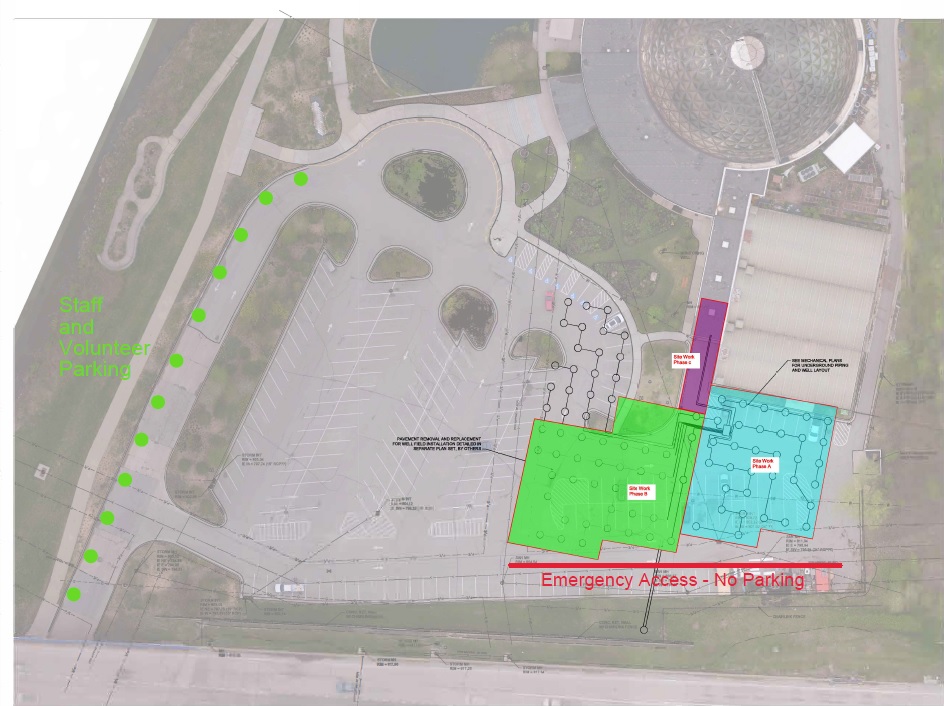The Greater Des Moines Botanical Garden is undergoing a complete heating, ventilation, and air conditioning (HVAC) retrofit project. In addition to replacing all boilers, air handling units, and exhaust fans, a geothermal well field is being installed to supplement the new system. Utilizing geothermal heating and cooling allows us to reduce our energy costs and our carbon footprint.

Project Details
Much of the existing HVAC system in the facility is original, dating to 1979. This project will allow us to replace this aged equipment with a new, robust system with higher efficiency. Geothermal heating and cooling was identified as the ideal system type to install in order to reduce our natural gas consumption, saving the organization money while also aligning with our sustainability goals. The geothermal system will supplement new, high efficiency boilers to heat our conservatory, greenhouses, office, and guest facing areas.
Project Timeline
Project Timeline
October 2023-July 2024: Air handling unit (AHU) replacement
FAQs
How does a geothermal heating and cooling system function?
Geothermal heating takes advantage of the relatively stable underground temperature of the earth. First, a pipe filled with a heat-exchange fluid (glycol & water) is lowered into a 300 foot well. This is called the ground loop system. Our system will have 70 wells. A geothermal heat pump extracts heat from the earth. This heat is then transferred to our boiler system, reducing the amount of natural gas consumed. The heat energy collected from our geothermal systems allows us to use less natural gas, reducing our carbon footprint.

What makes a geothermal system different from more conventional HVAC systems?
A traditional HVAC system relies on conventional means of exchanging heat, which may become less efficient depending on outside air conditions. For example, it’s less efficient for your home air conditioning system to transfer heat outdoors on a summer day, when the ambient temperature is also hot. Geothermal systems are more efficient because the temperature of the earth is stable year-round and are not exposed to outdoor elements.
Do geothermal heating and cooling systems require a lot of maintenance?
The closed loop well field requires very little maintenance. Installed properly, the closed loop system will function for decades. The mechanical components, including the pumps, require routine maintenance like any piece of equipment. Since all the geothermal equipment is centrally located in the basement, maintenance is hassle-free compared to a conventional system that has components exposed to the elements.
How deeply are geothermal ground loops buried?
Each of the 70 wells is 300 feet deep for our project. This depth can vary depending on a site’s geology.
Heating is mentioned in the project description, but can a geothermal system also keep the facility cool in the summer?
Yes. Our new system will use the geothermal system to chill water to support the cooling systems for the lobby, staff offices, restaurant, and North Gallery. Due to infrastructure constraints, we cannot cool our conservatory. However, we will be using the geothermal system to heat the conservatory.
Will parking be affected during the project?
Yes. While the portion of the parking lot that most heavily impacted where staff and volunteers typically park, it is close to complete. Soon 40 of our 180 parking spots will be available again.

Who can I contact if I have questions about this project?
If you are working with a member or our rentals team on an upcoming rental, please reach out to them about questions you may have relating to our HVAC project. All other inquiries can be directed to our Facilities Manager Austin Coulter at acoulter@dmbotanicalgarden.com.
